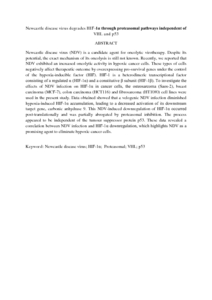Citation
Abd Aziz, Noraini and Stanbridge, Eric John and Shafee, Norazizah
(2016)
Newcastle disease virus degrades HIF-1a through proteasomal pathways independent of VHL and p53.
Journal of General Virology, 97 (12).
pp. 3174-3182.
ISSN 0022-1317; ESSN: 1465-2099
Abstract
Newcastle disease virus (NDV) is a candidate agent for oncolytic virotherapy. Despite its potential, the exact mechanism of its oncolysis is still not known. Recently, we reported that NDV exhibited an increased oncolytic activity in hypoxic cancer cells. These types of cells negatively affect therapeutic outcome by overexpressing pro-survival genes under the control of the hypoxia-inducible factor (HIF). HIF-1 is a heterodimeric transcriptional factor consisting of a regulated α (HIF-1α) and a constitutive β subunit (HIF-1β). To investigate the effects of NDV infection on HIF-1α in cancer cells, the osteosarcoma (Saos-2), breast carcinoma (MCF-7), colon carcinoma (HCT116) and fibrosarcoma (HT1080) cell lines were used in the present study. Data obtained showed that a velogenic NDV infection diminished hypoxia-induced HIF-1α accumulation, leading to a decreased activation of its downstream target gene, carbonic anhydrase 9. This NDV-induced downregulation of HIF-1α occurred post-translationally and was partially abrogated by proteasomal inhibition. The process appeared to be independent of the tumour suppressor protein p53. These data revealed a correlation between NDV infection and HIF-1α downregulation, which highlights NDV as a promising agent to eliminate hypoxic cancer cells.
Download File
![[img]](http://psasir.upm.edu.my/53381/1.hassmallThumbnailVersion/Newcastle%20disease%20virus%20degrades%20HIF-1%CE%B1%20through%20proteasomal%20pathways%20independent%20of%20VHL%20and%20p53.pdf)  Preview |
|
PDF
Newcastle disease virus degrades HIF-1α through proteasomal pathways independent of VHL and p53.pdf
Download (129kB)
| Preview
|
|
Additional Metadata
Actions (login required)
 |
View Item |

